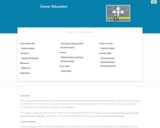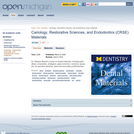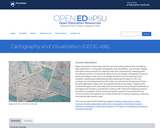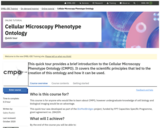
Course on Career Education to be adapted for high school instruction.
- Subject:
- Career and Technical Education
- Material Type:
- Full Course
- Textbook
- Author:
- Beth Boggs
- Mountain Empire Community College
- Date Added:
- 06/06/2024

Course on Career Education to be adapted for high school instruction.

During the Spring 2022 semester, I had the privilege to interview numerous teachers, administrators, and students at my college (RCTC) and our local public high schools (RPS) about developing a career exploration curriculum for undecided high school students. Based on these interviews, I have developed a set of curricular resources that encourages student exploration and planning. If you have any questions, or just want to connect, please email me at <mike.mutschelknaus@rctc.edu> I look forward to hearing from you.

This course has been designed as a seminar to give students an understanding of how scientists with medical or scientific degrees conduct research in both hospital and academic settings. There will be interactive discussions with research clinicians and scientists about the career opportunities and research challenges in the biomedical field, which an MIT student might prepare for by obtaining an MD, PhD, or combined degrees. The seminar will be held in a case presentation format, with topics chosen from the radiological sciences, including current research in magnetic resonance imaging, positron emission tomography and other nuclear imaging techniques, and advances in radiation therapy. With the lectures as background, we will also examine alternative and related options such as biomedical engineering, medical physics, and medical engineering. We’ll use as examples and points of comparisons the curriculum paths available through MIT’s Department of Nuclear Science and Engineering. In past years we have given very modest assignments such as readings in advance of or after a seminar, and a short term project.

Dr. Stephen Bayne's course on dental materials, including gold alloys, composites, amalgams, glass ionomers, ceramics, waxes, etc. for operative dentistry, fixed and removable prosthodontics.

Data Carpentry, Software Carpentry, and Library Carpentry are branches under The Carpentries known as a learning program to develop and teach workshops on the fundamental data and coding skills needed to conduct research. Participants can request to host a workshop at their institution or organization, attend a workshop, and/or involve by becoming a certified instructor, contributing in developing the content, or just simply support the programs. All lessons in either Carpentry branch can be used to teach introduction courses in data science/library information sciences.

Carrier systems involve the design, operation and management of transportation networks, assets, personnel, freight and passengers. In this course, we will present models and tools for analyzing, optimizing, planning, managing and controlling carrier systems.

Maps capture the power of place. A well-designed map can stoke our imagination, helping us to understand how a place looks or feels. Maps serve two roles. First, maps facilitate visual communication where knowns are presented to map readers. Second, maps permit visual thinking where insights into patterns and trends in spatial data are explored. In GEOG 486, Cartography & Visualization, you will learn and apply cartographic theory creating appropriately designed maps. You will learn how to associate the visual variables to symbolize types of spatial data. This process creates an appropriate visual hierarchy that conveys an informational hierarchy about the underlying message. Thus, techniques in map design will be applied to produce, evaluate, and critique reference and thematic maps.

This course serves as an introduction to urban form and design, focusing on the physical, historical, and social form of cities. Selected cities are analyzed, drawn, and compared, to develop a working understanding of urban and architectural form. The development of map making and urban representation is discussed, and use of the computer is required. A special focus is placed on the historical development of the selected cities, especially mid-nineteenth and mid-twentieth century periods of expansion. Readings focus on urban design theory in the twentieth century and will be discussed during a weekly seminar on them. This is a methods class for S.M.Arch.S. students in Architecture and Urbanism.

TV programs such as “Law and Order” show how forensic experts are called upon to give testimony that often determines the outcome of court cases. Engineers are one class of expert who can help display evidence in a new light to solve cases. In this seminar you will be part of the problem-solving process, working through both previously solved and unsolved cases. Each week we will investigate cases, from the facts that make up each side to the potential evidence we can use as engineers to expose culprits. The cases range from disintegrating airplane engines to gas main explosions to Mafia murders. This seminar will be full of discussions about the cases and creative approaches to reaching the solutions. The approach is hands-on so you will have a chance to participate in the process, not simply study it. Some background reading and oral presentation are required.

The MIT Case Studies in Social and Ethical Responsibilities of Computing (SERC) aims to advance new efforts within and beyond MIT’s Stephen A. Schwarzman College of Computing. The specially commissioned and peer-reviewed cases are brief and intended to be effective for undergraduate instruction across a range of classes and fields of study. The series editors expect the cases will also be of interest for computing professionals, policy specialists, and general readers. All cases will be made freely available via open-access publishing, with author retained copyright, through Creative Commons licensing.
The Series Editors interpret “social and ethical responsibilities of computing” broadly. Some cases focus closely on particular technologies, others on trends across technological platforms. Still others examine social, historical, philosophical, legal, and cultural facets that are essential for thinking critically about present-day efforts in computing and data sciences.

These case-studies in U.S. history attempt to break away from the white racial frame that too often is used to tell the story of America's past. These resources explore the United States from the vantage of the enslaved, exploited, persecuted, conquered and occupied who made possible the realization of others' wealth and dreams.

The goal of this class is to prove that category theory is a powerful language for understanding and formalizing common scientific models. The power of the language will be tested by its ability to penetrate into taken-for-granted ideas, either by exposing existing weaknesses or flaws in our understanding, or by highlighting hidden commonalities across scientific fields.

This course examines the causes of war, with a focus on practical measures to prevent and control war. Topics include causes and consequences of misperception by nations; military strategy and policy as cause of war; religion and war; U.S. foreign policy as a cause of war and peace; and the likelihood and possible nature of great wars in the future.
The historical cases covered include World War I, World War II, the Korean War, the Seven Years’ War, the Arab-Israel conflict, other recent Mideast wars, and the Peloponnesian War.

The goal of this course is to teach both the fundamentals of nuclear cell biology as well as the methodological and experimental approaches upon which they are based. Lectures and class discussions will cover the background and fundamental findings in a particular area of nuclear cell biology. The assigned readings will provide concrete examples of the experimental approaches and logic used to establish these findings. Some examples of topics include genome and systems biology, transcription, and gene expression.

Mechanical forces play a decisive role during development of tissues and organs, during remodeling following injury as well as in normal function. A stress field influences cell function primarily through deformation of the extracellular matrix to which cells are attached. Deformed cells express different biosynthetic activity relative to undeformed cells. The unit cell process paradigm combined with topics in connective tissue mechanics form the basis for discussions of several topics from cell biology, physiology, and medicine.


This course explores the major areas of cellular and molecular neurobiology, including excitable cells and membranes, ion channels and receptors, synaptic transmission, cell-type determination, axon guidance, neuronal cell biology, neurotrophin signaling and cell survival, synapse formation and neural plasticity. Material includes lectures and exams, and involves presentation and discussion of primary literature. It focuses on major concepts and recent advances in experimental neuroscience.

In this unit, students look at the components of cells and their functions and discover the controversy behind stem cell research. The first lesson focuses on the difference between prokaryotic and eukaryotic cells. In the second lesson, students learn about the basics of cellular respiration. They also learn about the application of cellular respiration to engineering and bioremediation. The third lesson continues students' education on cells in the human body and how (and why) engineers are involved in the research of stem cell behavior.

In this course we will explore how altered metabolism drives cancer progression. Students will learn (1) how to read, discuss, and critically evaluate scientific findings in the primary research literature, (2) how scientists experimentally approach fundamental issues in biology and medicine, (3) how recent findings have challenged the traditional “textbook” understanding of metabolism and given us new insight into cancer, and (4) how a local pharmaceutical company is developing therapeutics to target cancer metabolism in an effort to revolutionize cancer therapy.

This quick tour provides a brief introduction to the Cellular Microscopy Phenotype Ontology (CMPO). It covers the scientific principles that led to the creation of this ontology and how it can be used.
By the end of the course you will be able to:
Describe the role of CMPO
Search and browse the ontology and use it to annotate data